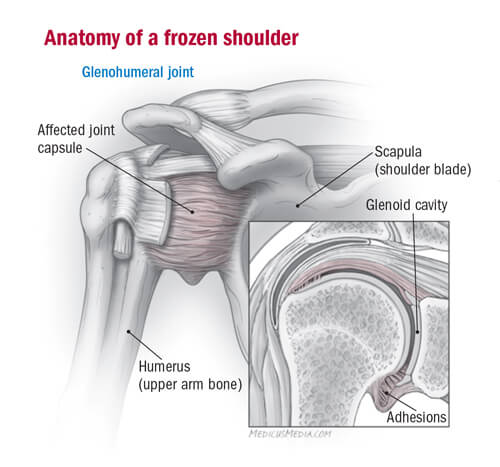Frozen Shoulder
Overview
Your shoulder hurts immensely and you can’t make any use of it as it doesn’t have much movement available due to a sudden increase in stiffness. There wasn’t probably a precipitating factor or reason to explain it. You may have heard of it before and you’re likely facing a frozen shoulder, also known as a Adhesive Capsulitis.

In a frozen shoulder, the structure that is affected is the capsule of the ball and socket joint: the gleno-humeral joint (Sharma, 2016). All the main joints in our body have a capsule, a sack the envelopes the joint and the lubricating fluid there is in it. This envelope/sack, called capsule, has to be, in some way, stretchable to allow joint movement. According to research, in a frozen shoulder, there seems to be an inflammatory retraction/shortening/shrinking (Hsu et al, 2011; Wiley 1991) of this capsule leading to the formation of adhesions, restricting in the movements that occur inside it and consequently the main shoulder movements, along with pain that can be felt deep in the joint and run down the arm and is often worse at night.
Request An Appointment with Lakky Physio
Causes
There is still no complete understanding on why it happens and how it is triggered, but it can come as a result of a significant trauma to the shoulder or following a shoulder tendinopathy, but sometimes just starts out of the blue. According to research, being a diabetic seems to be a risk factor for it (Kingston, 2018).
Symptoms
Three phases are usually described to explain the evolution of the frozen shoulder (Nagy et al, 2013):
- The initial (freezing) phase is characterised by marked pain and lasts approximately three months.
- The frozen (adhesive) phase lasts for 3-9 months, with significant stiffness and pain at the extremes of movement.
- The thawing (resolution) phase lasts for 9-18 months, is relatively painless, with stiffness improving steadily during this phase.
Depending on the stage you’re in, the approach of physiotherapy will vary focusing more on relieving the pain or restoring the range of movement.
Treatment
In terms of physiotherapy, the help you’ll be given will include advice on activities adaptation and on exercises that will help you on the path of freeing up the shoulder capsule and joint as suggested by Kraal et al (2018).
Acupuncture my have an important role in the pain management on the early stages, allowing you to rest and sleep better and hopefully go through your day with less pain.
If the pain is too severe and is failing to improve with physiotherapy, a last resort cortico-steroid injection can be of benefit to help breaking the deadlock of pain and dysfunction, but is not guaranteed to have a good outcome, especially if the home exercises are not done regularly.
Recovery
The recovery of such condition may take months to years to happen (Maund E, Craig D, Suekarran, 2012), therefore the first skill you need to manage it is to be a “patient” patient. It is vital to learn what activities aggravate your pain and sensibly develop strategies on how to do your everyday activities differently as the shoulder movement restriction is going to be present for a long period. A physiotherapist can show you how far to push yourself and teach you the appropriate exercises.
References:
- Kraal T, Sierevelt I, van Deurzen D, van den Bekerom MP, Beimers L (2018) Cortico steroid injection alone vs additional physiotherapy treatment in early stage frozen shoulders, World J Orthop. 2018 Sep 18;9(9):165-172. doi: 10.5312/wjo.v9.i9.165. eCollection 2018 Sep 18.
- Kingston K, Curry EJ, Galvin JW, Li X (2018) Shoulder adhesive capsulitis: epidemiology and predictors of surgery; J Shoulder Elbow Surg. 2018 Aug;27(8):1437-1443. doi: 10.1016/j.jse.2018.04.004. Epub 2018 May 25.
- Hsu JE, Anakwenze OA, Warrender WJ, Abboud JA. Current review of adhesive capsulitis. J Shoulder Elbow Surg. 2011;20(3):502–14.
- Wiley AM (1991) Arthroscopic appearance of frozen shoulder. Arthroscopy. 7(2):138–43.
- Sharma SP, Bærheim A, Moe-Nilssen R, Kvåle A, (2016), Adhesive capsulitis of the shoulder, treatment with corticosteroid, corticosteroid with distension or treatment-as-usual; a randomised controlled trial in primary care, BMC Musculoskeletal Disorders (2016) 17:232
- Maund E, Craig D, Suekarran S, et al (2012) Management of frozen shoulder: a systematic review and cost-effectiveness analysis. Health Technol Assess. 2012;16:1–264.
- Nagy MT, MacFarlane RJ, Khan Y, Waseem M (2013), The Frozen Shoulder: Myths and Realities, Open Orthop J. 2013; 7: 352–355.
- Harvard Health Publishing, (2014), Frozen Shoulder [online] Available at: https://www.health.harvard.edu/shoulders/frozen-shoulder [Accessed 14 March 2019]
